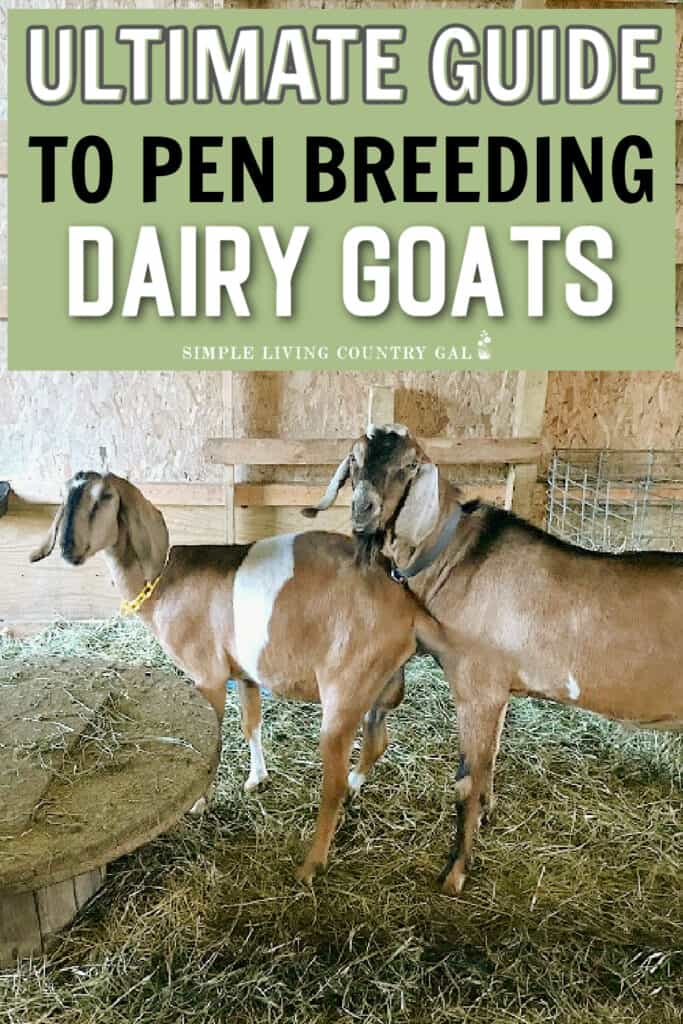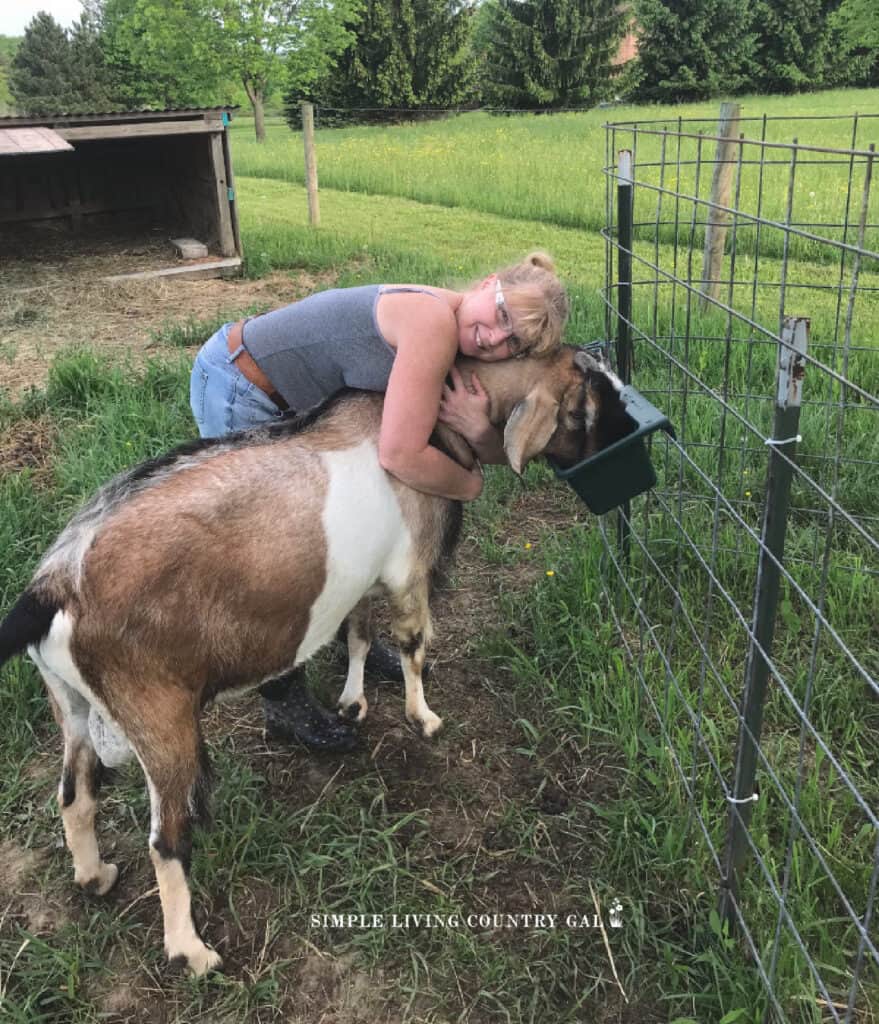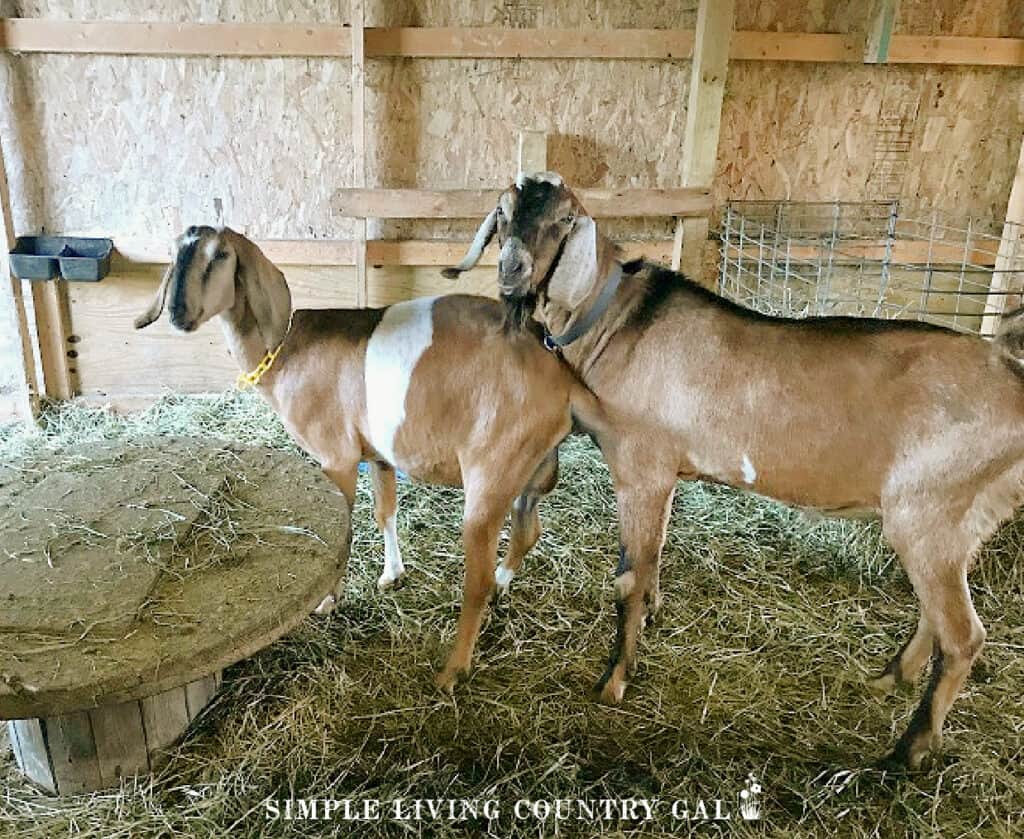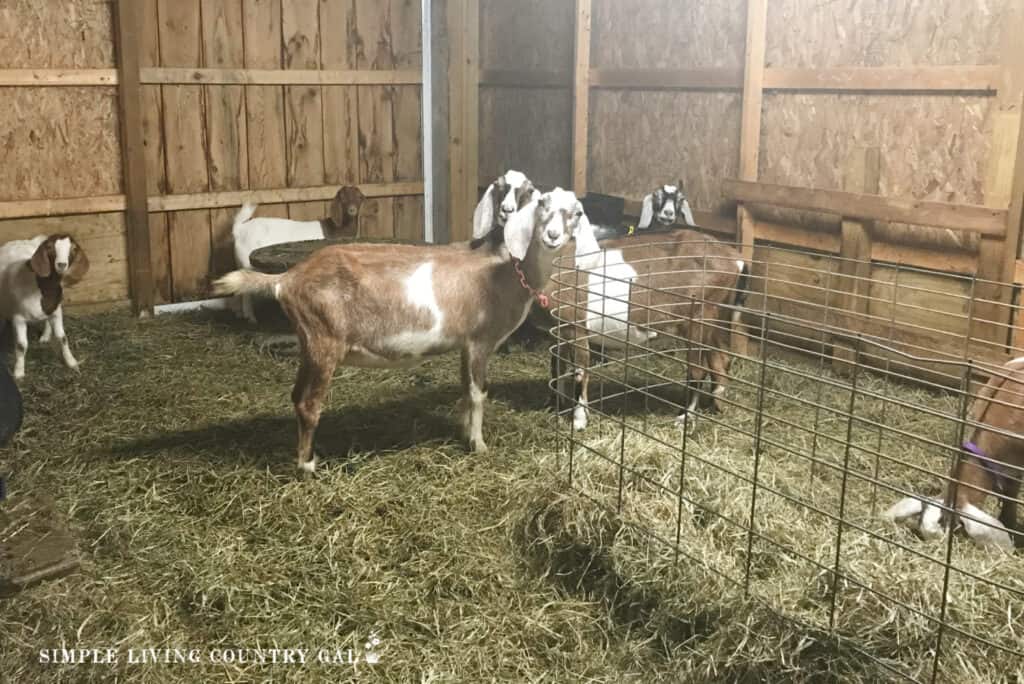Pen Breeding Goats
Pen breeding goats is a great way to be more in control of breeding times and kidding dates. This easy approach to breeding allows you to breed your goats within your timeframe.
Goat breeding and boat kidding approaches that help you raise a herd that is resilient and healthier from the time they are born.

What is pen breeding?
Pen breeding is a method of breeding goats in which a buck and doe or does are placed together in a confined space, typically a pen or an enclosed area of a barn. They are usually kept together for a designated period of time to encourage mating. This controlled environment allows for closer monitoring of the breeding process and can help ensure successful pregnancies on a more specific timeline.
Try out Our Goat Gestation Calculator here
Benefits of Pen Breeding
We prefer pen breeding with our goats, and there are several reasons why.
#1. Control over breeding times: With pen breeding, you have the flexibility to choose when you want your goats to breed, rather than relying on natural mating, which can be unpredictable. This is especially helpful if you live in a cold weather area as we do. Kids tend to do better when they are born in friendlier weather.
#2. Better genetics: By choosing which bucks and does to put together in the pen, you have more control over the genetics of your herd. This allows you to carefully select desirable traits such as milk production, hardiness, and temperament.
#3. Great chance of successful breeding: When goats are confined in a pen together, the chances of breeding and successful pregnancies are higher. This is because the male goat can more easily cover all females in the pen, and there is less chance of interference from other males.
The Importance of Selecting the Right Breeds
When it comes to breeding goats, selecting the right breeds is important for the success and health of your herd. When we first started with our own goats our goal was to have kids. Now, we are more intentional with our pair ups because the offspring really does affect the success of our homestead.
We have also found that different breeds have different characteristics that do better in our harsh and unpredictable weather. There are other reasons to consider as well:
- Climate: Some goat breeds are better suited for warmer climates, while others do well in colder temperatures. There are also goats that stand up better in wet areas and some that thrive in dry. Knowing each of your goat’s strong points will better help you to guide your breeding program.
- Purpose: Certain breeds are known for their milk production, others for their meat, and some are better suited as pets or for fiber. Decide what you want your goats for and choose breeds that align with those goals.
- Temperament: Some breeds are known for being more docile and easy to handle, while others are more independent and have a higher energy level. Consider your own handling abilities and purposes for the goats when selecting breeds that will fit well with your lifestyle.

Setting up a Breeding Pen
Here are some tips for setting up a breeding pen that will help ensure success:
#1. Separate males from females: It is important to keep male goats separated from females until you are ready for them to breed. This helps prevent unwanted pregnancies and also allows you to control when the breeding occurs. We keep our does in the main barn year-round with an access point to our pasture. We keep our male goats, both intact and wethered, in an outside shelter with a separate grazing area. The boys are able to see the does but an electric fence keeps them out of the girl’s area until we are ready to breed.
#2. Provide adequate space: A breeding pen should have enough space for the male goat to comfortably cover the female without any additional stress or crowding. This will also help prevent any injuries to the goats during breeding. A general rule of thumb is 20 square feet per adult goat in a pen.
#3. Keep multiple water, mineral, and hay areas: It is important to provide multiple water, mineral, and hay areas in the breeding pen to avoid any competition or aggression between goats. Bucks in rut can sometimes get a bit territorial, and we have found that having multiple areas for food and water cuts back on aggression in our herd.

#4. Keep pens clean: A clean and well-maintained breeding pen helps prevent the spread of diseases and keeps the goats healthy during this crucial time. Regularly cleaning out manure and providing fresh bedding will also help reduce the risk of infection.
#5. Consider using a marking harness: A marking harness is a tool used to track the breeding activity of goats. It consists of a harness that goes around the male goat’s chest and has a crayon attached to it. As the male breeds, the crayon will mark the female, indicating successful breeding. This can be helpful in identifying which does have been bred giving you a better timeline for kidding.
Great Goat Breeding Tools:
Goat Pulling Harness with Tugs Pulling Carts, Wagons Brush Work (Standard, Red)


The Breeding Process
Male and female goats breed in a straightforward manner. The process begins when the female goat, also known as the doe, enters into her heat cycle, which typically occurs every 18 to 23 days and lasts approximately 1-2 days. During this time, she will display signs of readiness to mate, such as increased tail flagging, mucus discharge, and vocalization all of which attract the male goat or buck.
The buck will often respond with intense focus. He may display behaviors like tail flicking, urinating on himself to emit a strong scent, and making snorting noises that sound like “blubbering” to attract the doe’s attention. If the doe is receptive, she will allow the buck to mount her, indicating successful mating.
Breeding can occur multiple times during the doe’s heat cycle to increase the chances of successful fertilization. After the mating process, gestation in goats usually lasts for about 150 days, after which the doe will give birth to one or more kids.

Introducing Bucks and Does: Steps and Precautions
When introducing a buck in rut to your herd of does, it is crucial to take precautions and follow specific steps to ensure the safety of all animals involved.
- Quarantine: Before introducing a new buck, always quarantine him for at least three weeks in a separate area from your does. This will allow you to monitor his health and behavior for any signs of illness or aggression before introducing him to the herd.
- Selective breeding: It is essential to carefully select the does you want to breed with a specific buck. Choose does that are in good health, have desirable traits, and are well-suited for your breeding goals.
- Introduce gradually: When it’s time to introduce the buck to the does, do it gradually. Start by allowing him to interact with one doe at a time until you are confident that he is not showing any signs of aggression or dominance. You also want to be sure your doe is receptive. If your buck is chasing your doe around, you may want to wait a day and try again. Breeding can be physically exhausting for a buck, especially if he has more than one doe to breed. The role of pen breeding is to put goats together that are both willing and able.
- Supervision: Always supervise interactions between the buck and does, especially during the initial introductions. This will allow you to intervene if any aggressive behavior occurs.
- Separate feeding: Provide separate feeding areas for the buck and does to avoid any competition or fighting over food. This will also prevent your buck from becoming territorial over the does’ food.
- Ensure enough space: Make sure your enclosure has enough space for all animals to move around and retreat if needed. Crowded spaces can lead to aggression and injuries, so it’s essential to provide enough space for the animals to live comfortably.
- Monitor health: Regularly check on the health of your breeding goats, including the buck. This includes checking for signs of illness or injury and ensuring they have access to clean water and food at all times.
Post-Breeding Care
After the breeding season is over, there are a few things you should keep in mind to ensure the health and well-being of your goats:
- Keep an eye on pregnant does: Monitor your pregnant does closely, providing extra care and attention as needed. This includes proper nutrition, shelter, and regular check-ups with a veterinarian.
- Provide a clean and comfortable environment: Keep your goats’ living area clean and comfortable, especially during the late stages of pregnancy. This will reduce stress and potential complications during birth.
- Prepare for kidding: As the due date approaches, prepare a separate area for the doe to give birth. Make sure it is clean, warm, and private to reduce stress on the doe.
Should you separate your buck once the does are bred?
This is a common question among goat breeders, and the answer will depend on your specific situation. Some breeders prefer to keep their buck separate from the does throughout the year, while others may allow them to be with the herd until breeding season begins.
For us, we keep our buck in with our does until kidding season begins. The main reason is that our winters are hard and long, and we want our herd together in the main barn, where it is warm and dry. Come spring, our male goats will all move outside to their summer shelter until it is time to breed again.

Read: How to Keep Bucks Successfully
Pen breeding dairy goats is a great way to create a breeding system that you are more in control of. Yes, it requires attention, care, and a good understanding of your goats’ well-being, but we feel it is the best way to breed a herd in a more controlled way. Regardless of your approach, the key is to provide a clean, comfortable environment and appropriate nutrition for your herd. With patience and diligence, you can successfully breed your dairy goats and enjoy fresh milk all year long.
More Goat Breeding Resources:
- How to Naturally Prepare your Goats for Breeding Season.
- Signs of a Goat in Heat
- Driveway Breeding Goats




